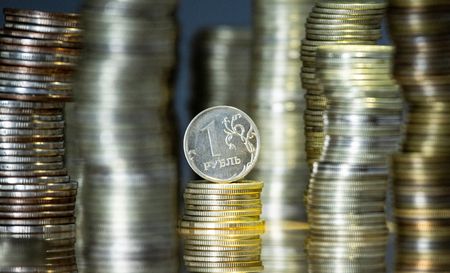By Alexander Marrow
(Reuters) -The rouble recovered from more than a 16-month low past 98 to the dollar on Wednesday after the central bank intervened to try and halt the Russian currency’s slide, effectively abandoning its budget rule by stopping planned foreign exchange purchases.
The rouble had sunk to 98.0725 earlier in the session, its weakest point against the dollar since March 25, 2022, hampered by strong foreign currency demand and limited supply, but it pared almost all its losses after the central bank’s move.
By 1625 GMT, the rouble was 0.1% weaker against the dollar at 97.20. It had lost 0.2% to trade at 106.64 versus the euro and shed 0.1% against the yuan to 13.43.
The Bank of Russia said it would stop conducting the finance ministry’s foreign exchange purchases as prescribed by Russia’s budget rule, in order to reduce market volatility.
The central bank has given an encouraging signal by finally reacting to the national currency’s crash, said Yevgeny Suvorov, an economist at CentroCreditBank.
The central bank’s move ultimately means the net supply of foreign currency on the market will increase to 2.3 billion roubles from 500 million roubles a day.
“That’s not much to stop the rouble’s collapse,” Suvorov said. “But at least it’s something.”
SHRINKING SURPLUS
The rouble has been under pressure this year from Russia’s shrinking balance of trade, as export revenues fall and imports rebound, falling around 28% on a year-to-date basis from levels near 70 to the dollar.
Since an abortive armed mutiny in late June, the rouble has dropped almost 13%.
It also tends to struggle early each month after losing the support of a month-end tax period that sees exporting firms convert foreign exchange revenue to meet local liabilities.
“The limited supply of foreign currency from exporters continues to exert pressure on rouble positions, due to both problems with repatriating funds and also reduced export supplies in the face of steady demand among importers,” said Egor Zhilnikov, an analyst at Promsvyazbank.
Central bank data on Wednesday showed Russia’s current account surplus shrank by 85% in the January-July period.
Yields on Russia’s benchmark 10-year OFZ bond hit 11.72%, their highest since April 2022 and well above Russia’s 8.5% key rate.
Alor Broker’s Alexey Antonov said the rouble’s depreciation was largely responsible for the drop in bond prices, which move inversely to their yields.
Russia’s finance ministry, which on Tuesday said Russia’s budget deficit had widened to around $29 billion in the January-July period, held one OFZ auction on Wednesday and cancelled another due to a lack of acceptably priced bids.
Brent crude oil, a global benchmark for Russia’s main export, was 0.5% higher at $86.61 a barrel.
Russian stock indexes were higher.
The dollar-denominated RTS index was up 0.5% at 1,004.7 points. The rouble-based MOEX Russian index was 0.5% higher at 3,099.5 points.
(Reporting by Alexander Marrow; Editing by Andrew Heavens, Sharon Singleton and Paul Simao)





